engine YAMAHA JOG50R 2012 User Guide
[x] Cancel search | Manufacturer: YAMAHA, Model Year: 2012, Model line: JOG50R, Model: YAMAHA JOG50R 2012Pages: 76, PDF Size: 1.51 MB
Page 27 of 76
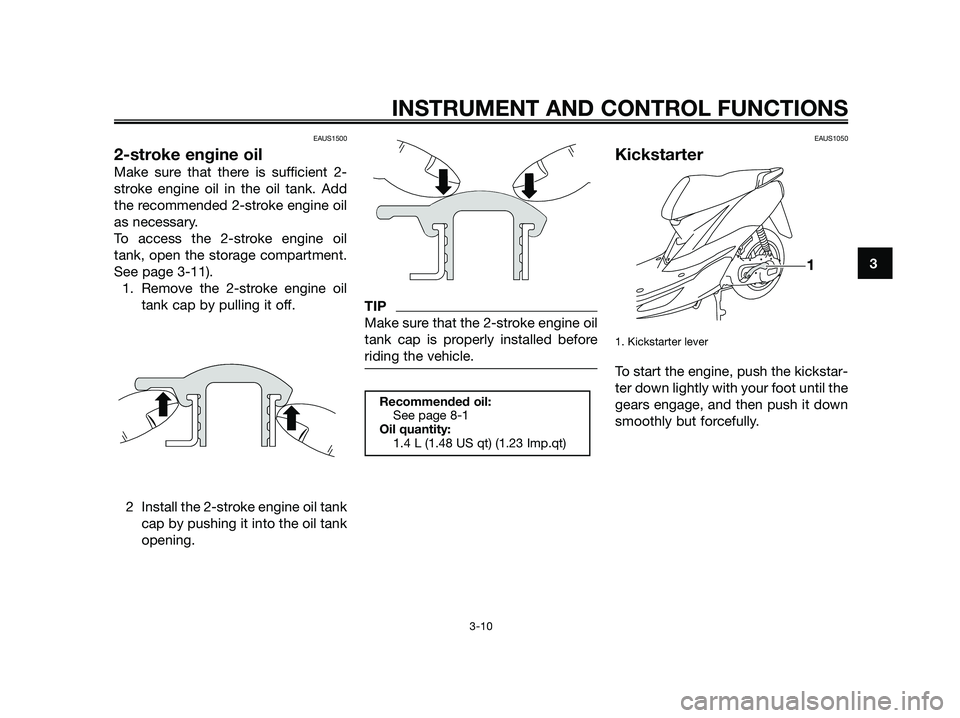
EAUS1500
2-stroke engine oil
Make sure that there is sufficient 2-
stroke engine oil in the oil tank. Add
the recommended 2-stroke engine oil
as necessary.
To access the 2-stroke engine oil
tank, open the storage compartment.
See page 3-11).
1. Remove the 2-stroke engine oil
tank cap by pulling it off.
2 Install the 2-stroke engine oil tank
cap by pushing it into the oil tank
opening.
TIP
Make sure that the 2-stroke engine oil
tank cap is properly installed before
riding the vehicle.
EAUS1050
Kickstarter
1. Kickstarter lever
To start the engine, push the kickstar-
ter down lightly with your foot until the
gears engage, and then push it down
smoothly but forcefully.
1
Recommended oil:
See page 8-1
Oil quantity:
1.4 L (1.48 US qt) (1.23 Imp.qt)
INSTRUMENT AND CONTROL FUNCTIONS
3-10
3
Page 32 of 76

FOR YOUR SAFETY – PRE-OPERATION CHECKS
4-2
4
EAU15605
Pre-operation check list
ITEM CHECKS PAGE
• Check fuel level in fuel tank.
Fuel• Refuel if necessary.3-8
• Check fuel line for leakage.
• Check oil level in oil tank.
2-stroke engine oil• If necessary, add recommended oil to specified level. 3-10
• Check vehicle for oil leakage.
Final transmission oil• Check vehicle for oil leakage. 6-7
• Check coolant level in reservoir.
Coolant (CS50Z)• If necessary, add recommended coolant to specified level. 6-8
• Check cooling system for leakage.
• Check operation.
• If soft or spongy, have Yamaha dealer bleed hydraulic system.
• Check brake pads for wear.
Front brake• Replace if necessary. 6-13, 6-14, 6-15
• Check fluid level in reservoir.
• If necessary, add recommended brake fluid to specified level.
• Check hydraulic system for leakage.
• Check operation.
Rear brake• Lubricate cable if necessary.
• Check lever free play.6-13, 6-14
• Adjust if necessary.
• Make sure that operation is smooth.
Throttle grip• Check cable free play.
• If necessary, have Yamaha dealer adjust cable free play 6-10, 6-16
and lubricate cable and grip housing.
• Check for damage.
Wheels and tires• Check tire condition and tread depth.
• Check air pressure.6-11, 6-12
• Correct if necessary.
Page 34 of 76
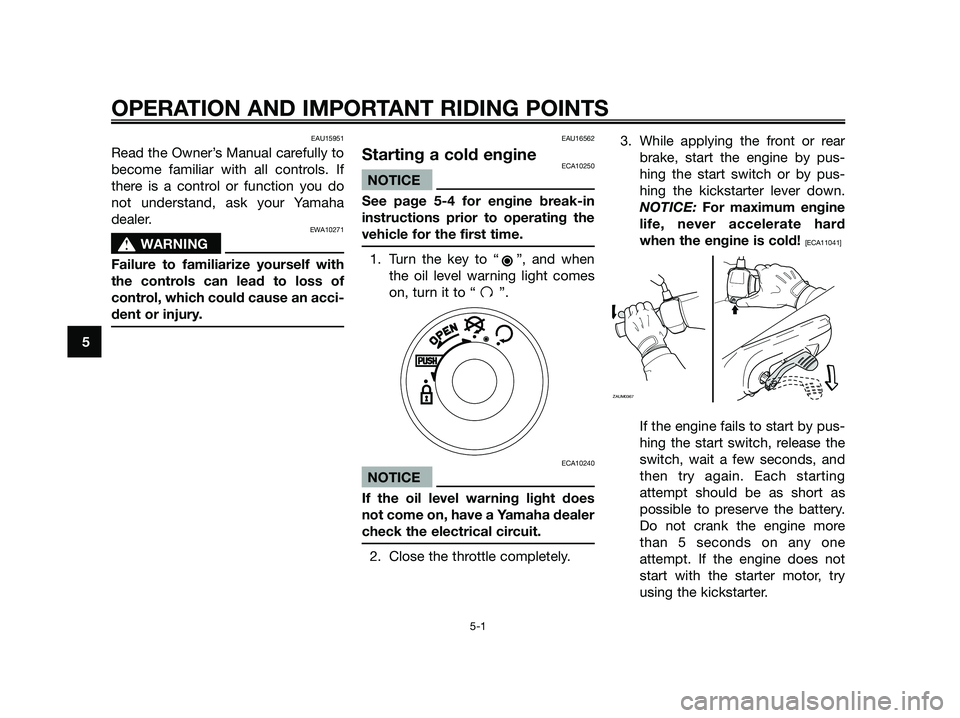
EAU15951
Read the Owner’s Manual carefully to
become familiar with all controls. If
there is a control or function you do
not understand, ask your Yamaha
dealer.
EWA10271
sWARNING
Failure to familiarize yourself with
the controls can lead to loss of
control, which could cause an acci-
dent or injury.
EAU16562
Starting a cold engineECA10250
NOTICE
See page 5-4 for engine break-in
instructions prior to operating the
vehicle for the first time.
1. Turn the key to “ ”, and when
the oil level warning light comes
on, turn it to “ ”.
ECA10240
NOTICE
If the oil level warning light does
not come on, have a Yamaha dealer
check the electrical circuit.
2. Close the throttle completely.3. While applying the front or rear
brake, start the engine by pus-
hing the start switch or by pus-
hing the kickstarter lever down.
NOTICE: For maximum engine
life, never accelerate hard
when the engine is cold!
[ECA11041]
If the engine fails to start by pus-
hing the start switch, release the
switch, wait a few seconds, and
then try again. Each starting
attempt should be as short as
possible to preserve the battery.
Do not crank the engine more
than 5 seconds on any one
attempt. If the engine does not
start with the starter motor, try
using the kickstarter.
ZAUM0367
OPERATION AND IMPORTANT RIDING POINTS
5-1
5
Page 35 of 76
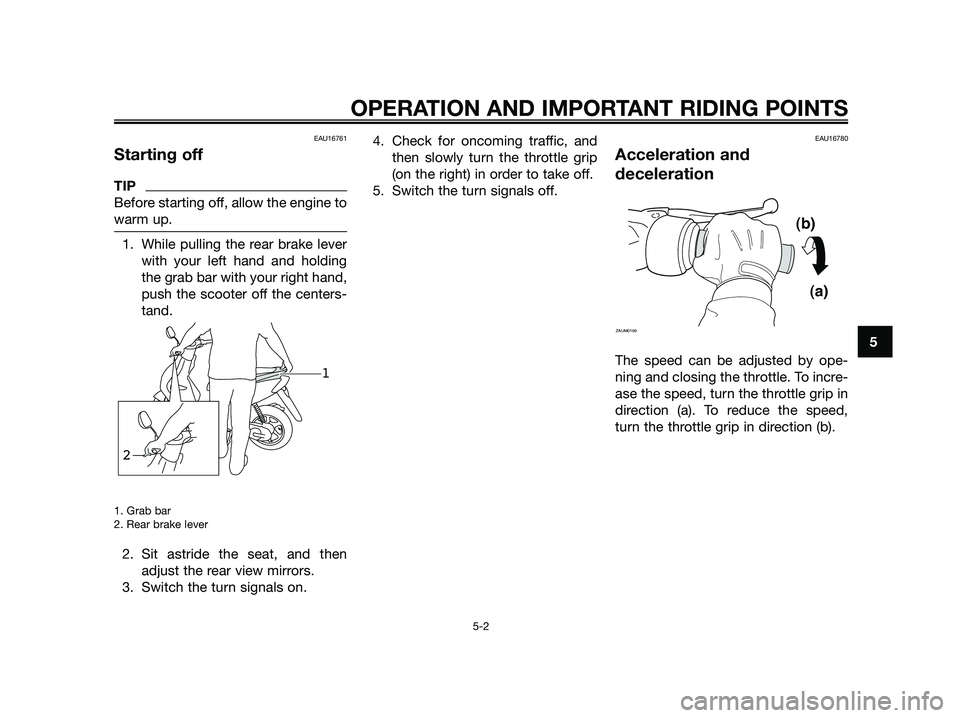
EAU16761
Starting off
TIP
Before starting off, allow the engine to
warm up.
1. While pulling the rear brake lever
with your left hand and holding
the grab bar with your right hand,
push the scooter off the centers-
tand.
1. Grab bar
2. Rear brake lever
2. Sit astride the seat, and then
adjust the rear view mirrors.
3. Switch the turn signals on.4. Check for oncoming traffic, and
then slowly turn the throttle grip
(on the right) in order to take off.
5. Switch the turn signals off.
EAU16780
Acceleration and
deceleration
The speed can be adjusted by ope-
ning and closing the throttle. To incre-
ase the speed, turn the throttle grip in
direction (a). To reduce the speed,
turn the throttle grip in direction (b).
(b)
(a)
ZAUM0199
21
OPERATION AND IMPORTANT RIDING POINTS
5-2
5
Page 36 of 76
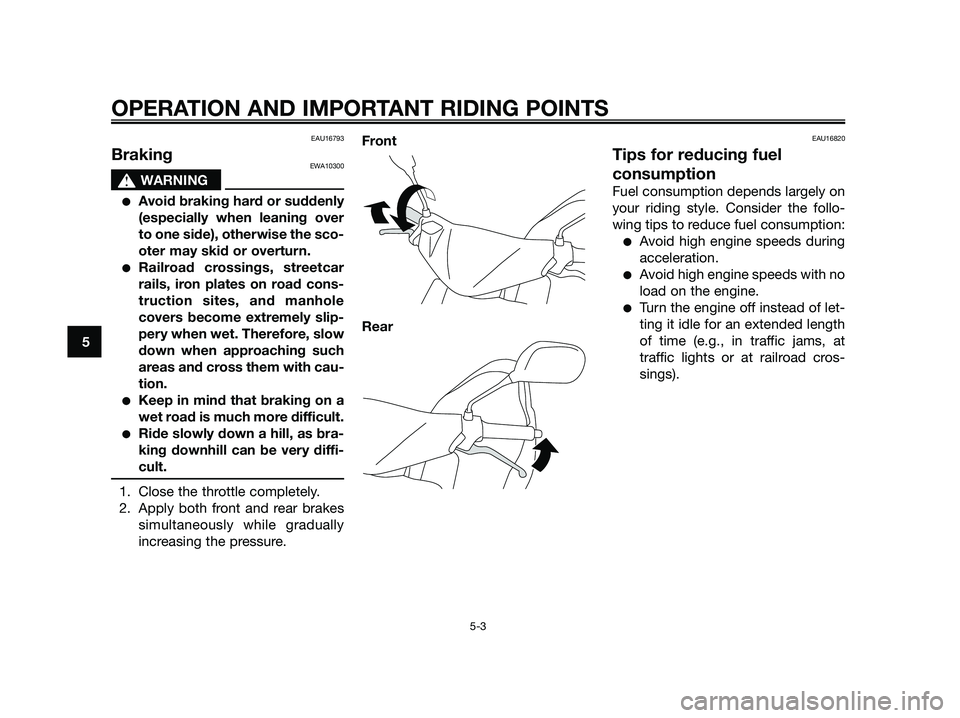
EAU16793
BrakingEWA10300
sWARNING
●Avoid braking hard or suddenly
(especially when leaning over
to one side), otherwise the sco-
oter may skid or overturn.
●Railroad crossings, streetcar
rails, iron plates on road cons-
truction sites, and manhole
covers become extremely slip-
pery when wet. Therefore, slow
down when approaching such
areas and cross them with cau-
tion.
●Keep in mind that braking on a
wet road is much more difficult.
●Ride slowly down a hill, as bra-
king downhill can be very diffi-
cult.
1. Close the throttle completely.
2. Apply both front and rear brakes
simultaneously while gradually
increasing the pressure.Front
Rear
EAU16820
Tips for reducing fuel
consumption
Fuel consumption depends largely on
your riding style. Consider the follo-
wing tips to reduce fuel consumption:
●Avoid high engine speeds during
acceleration.
●Avoid high engine speeds with no
load on the engine.
●Turn the engine off instead of let-
ting it idle for an extended length
of time (e.g., in traffic jams, at
traffic lights or at railroad cros-
sings).
OPERATION AND IMPORTANT RIDING POINTS
5-3
5
Page 37 of 76

EAU16830
Engine break-in
There is never a more important
period in the life of your engine than
the period between 0 and 1000 km
(600 mi). For this reason, you should
read the following material carefully.
Since the engine is brand new, do not
put an excessive load on it for the first
1000 km (600 mi). The various parts in
the engine wear and polish themsel-
ves to the correct operating clearan-
ces. During this period, prolonged
full-throttle operation or any condition
that might result in engine overhea-
ting must be avoided.
EAU17213
Parking
When parking, stop the engine, and
then remove the key from the main
switch.
EWA10311
sWARNING
●Since the engine and exhaust
system can become very hot,
park in a place where pedes-
trians or children are not likely
to touch them and be burned.
●Do not park on a slope or on
soft ground, otherwise the
vehicle may overturn, increa-
sing the risk of a fuel leak and
fire.
●Do not park near grass or other
flammable materials which
might catch fire.
OPERATION AND IMPORTANT RIDING POINTS
5-4
5
Page 38 of 76
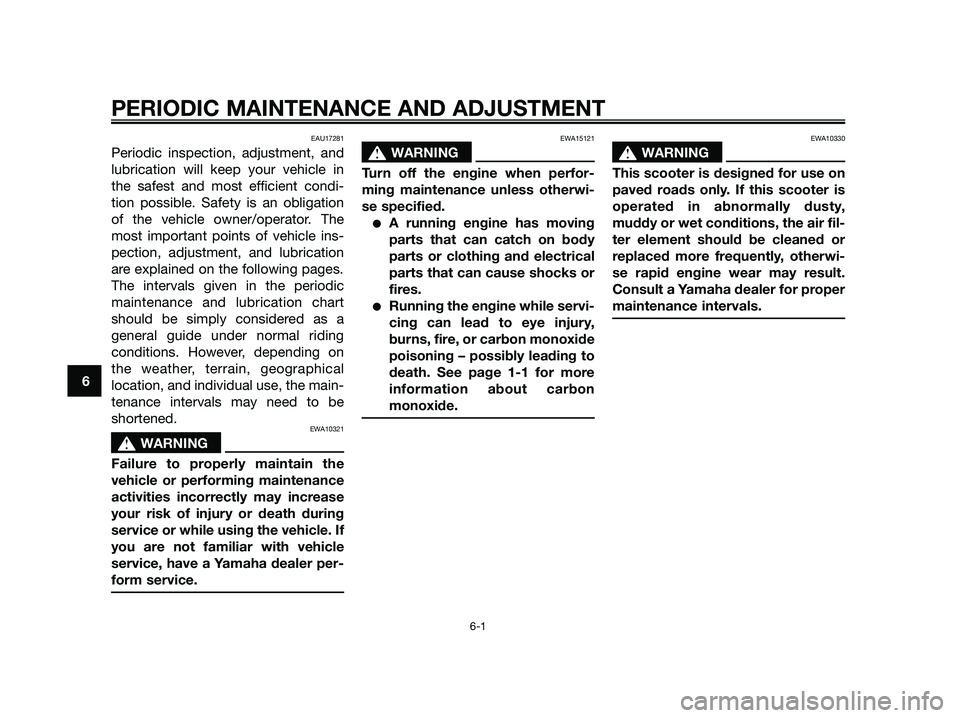
EAU17281
Periodic inspection, adjustment, and
lubrication will keep your vehicle in
the safest and most efficient condi-
tion possible. Safety is an obligation
of the vehicle owner/operator. The
most important points of vehicle ins-
pection, adjustment, and lubrication
are explained on the following pages.
The intervals given in the periodic
maintenance and lubrication chart
should be simply considered as a
general guide under normal riding
conditions. However, depending on
the weather, terrain, geographical
location, and individual use, the main-
tenance intervals may need to be
shortened.
EWA10321
sWARNING
Failure to properly maintain the
vehicle or performing maintenance
activities incorrectly may increase
your risk of injury or death during
service or while using the vehicle. If
you are not familiar with vehicle
service, have a Yamaha dealer per-
form service.
EWA15121
sWARNING
Turn off the engine when perfor-
ming maintenance unless otherwi-
se specified.
●A running engine has moving
parts that can catch on body
parts or clothing and electrical
parts that can cause shocks or
fires.
●Running the engine while servi-
cing can lead to eye injury,
burns, fire, or carbon monoxide
poisoning – possibly leading to
death. See page 1-1 for more
information about carbon
monoxide.
EWA10330
sWARNING
This scooter is designed for use on
paved roads only. If this scooter is
operated in abnormally dusty,
muddy or wet conditions, the air fil-
ter element should be cleaned or
replaced more frequently, otherwi-
se rapid engine wear may result.
Consult a Yamaha dealer for proper
maintenance intervals.
PERIODIC MAINTENANCE AND ADJUSTMENT
6-1
6
Page 40 of 76
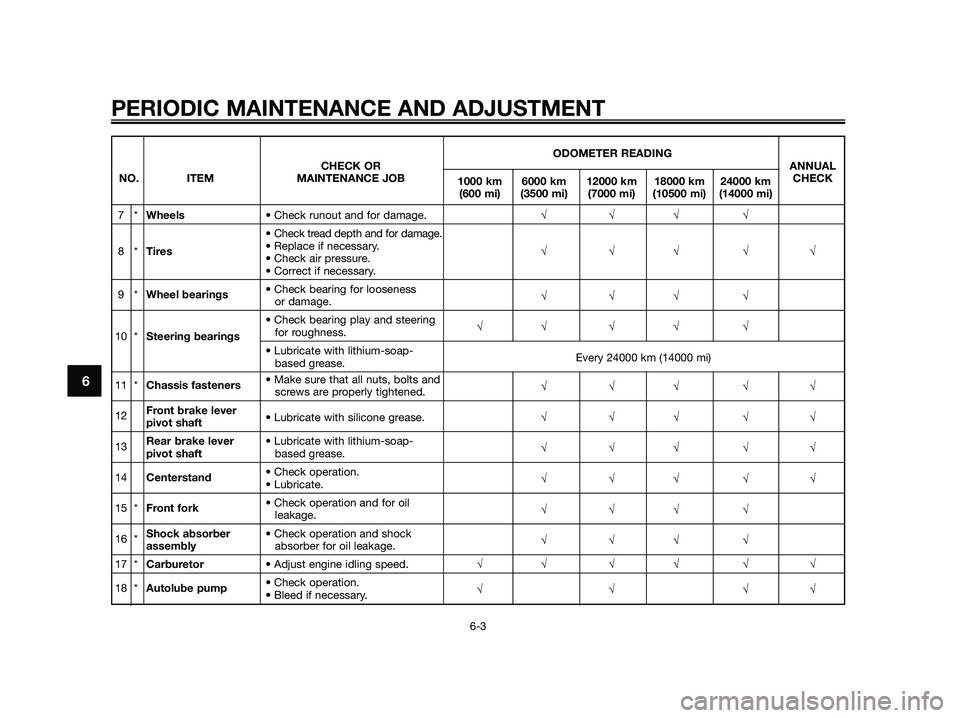
PERIODIC MAINTENANCE AND ADJUSTMENT
6-3
6
ODOMETER READING
CHECK OR ANNUAL
NO. ITEM MAINTENANCE JOB
1000 km 6000 km 12000 km 18000 km 24000 kmCHECK
(600 mi) (3500 mi) (7000 mi) (10500 mi) (14000 mi)
7*Wheels• Check runout and for damage.√√√ √
• Check tread depth and for damage.
8*Tires• Replace if necessary.
√√√ √√
• Check air pressure.
• Correct if necessary.
9*Wheel bearings• Check bearing for looseness
or damage.√√√ √
• Check bearing play and steering
10 *Steering bearingsfor roughness.√√ √√ √
• Lubricate with lithium-soap-
based grease.Every 24000 km (14000 mi)
11 *Chassis fasteners• Make sure that all nuts, bolts and
screws are properly tightened.√√√ √√
12Front brake lever
pivot shaft• Lubricate with silicone grease.√√√ √√
13Rear brake lever • Lubricate with lithium-soap-
pivot shaftbased grease.√√√ √√
14Centerstand• Check operation.
• Lubricate.√√√ √√
15 *Front fork• Check operation and for oil
leakage.√√√ √
16 *Shock absorber • Check operation and shock
assemblyabsorber for oil leakage.√√√ √
17 *Carburetor• Adjust engine idling speed.√√ √√ √ √
18 *Autolube pump• Check operation.
• Bleed if necessary.√√ √√
Page 43 of 76
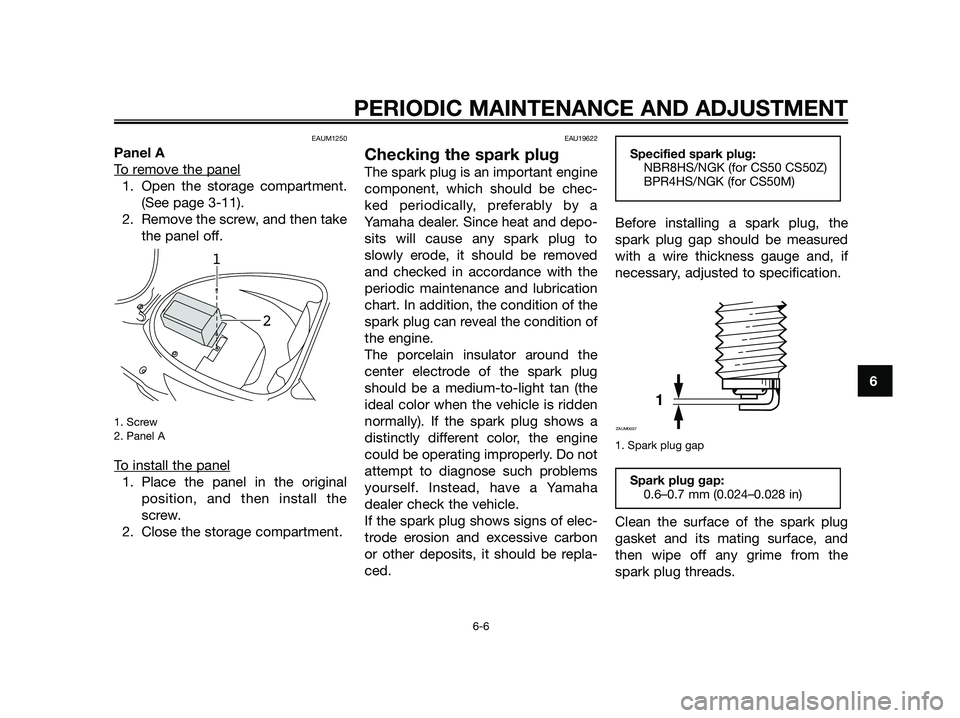
EAUM1250
Panel A
T
o remove the panel
1. Open the storage compartment.
(See page 3-11).
2. Remove the screw, and then take
the panel off.
1. Screw
2. Panel A
To install the panel
1. Place the panel in the original
position, and then install the
screw.
2. Close the storage compartment.
EAU19622
Checking the spark plug
The spark plug is an important engine
component, which should be chec-
ked periodically, preferably by a
Yamaha dealer. Since heat and depo-
sits will cause any spark plug to
slowly erode, it should be removed
and checked in accordance with the
periodic maintenance and lubrication
chart. In addition, the condition of the
spark plug can reveal the condition of
the engine.
The porcelain insulator around the
center electrode of the spark plug
should be a medium-to-light tan (the
ideal color when the vehicle is ridden
normally). If the spark plug shows a
distinctly different color, the engine
could be operating improperly. Do not
attempt to diagnose such problems
yourself. Instead, have a Yamaha
dealer check the vehicle.
If the spark plug shows signs of elec-
trode erosion and excessive carbon
or other deposits, it should be repla-
ced.Before installing a spark plug, the
spark plug gap should be measured
with a wire thickness gauge and, if
necessary, adjusted to specification.
1. Spark plug gap
Clean the surface of the spark plug
gasket and its mating surface, and
then wipe off any grime from the
spark plug threads.
Spark plug gap:
0.6–0.7 mm (0.024–0.028 in)
1
ZAUM0037
Specified spark plug:
NBR8HS/NGK (for CS50 CS50Z)
BPR4HS/NGK (for CS50M)
1
2
PERIODIC MAINTENANCE AND ADJUSTMENT
6-6
6
Page 44 of 76

TIP
If a torque wrench is not available
when installing a spark plug, a good
estimate of the correct torque is
1/4–1/2 turn past finger tight. Howe-
ver, the spark plug should be tighte-
ned to the specified torque as soon
as possible.
EAU20064
Final transmission oil
The final transmission case must be
checked for oil leakage before each
ride. If any leakage is found, have a
Yamaha dealer check and repair the
scooter. In addition, the final trans-
mission oil must be changed as
follows at the intervals specified in the
periodic maintenance and lubrication
chart.
1. Start the engine, warm up the
final transmission oil by riding the
scooter for several minutes, and
then stop the engine.
2. Place the scooter on the centers-
tand.
3. Place an oil pan under the final
transmission case to collect the
used oil.
4. Remove the final transmission oil
filler cap and final transmission
drain bolt to drain the oil from the
final transmission case.
1. Final transmission oil filler cap
5. Install the final transmission oil
drain bolt, and then tighten it to
the specified torque.
1. Final transmission oil drain bolt
1
1
11Tightening torque:
Spark plug:
20 Nm (2.0 m•kgf, 14.5 ft•lbf)
PERIODIC MAINTENANCE AND ADJUSTMENT
6-7
6